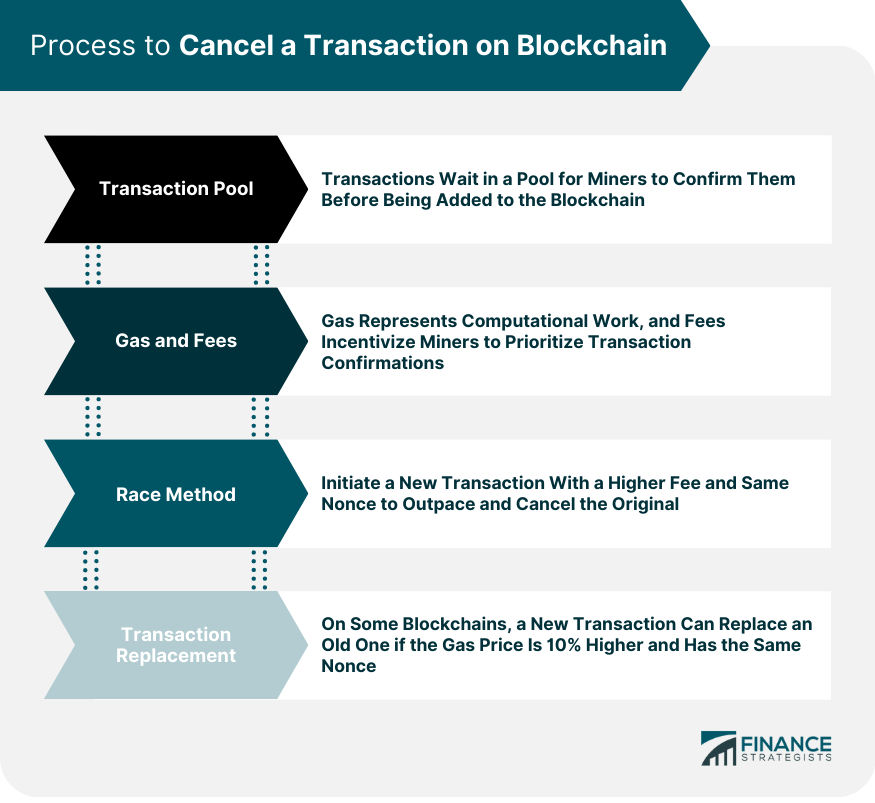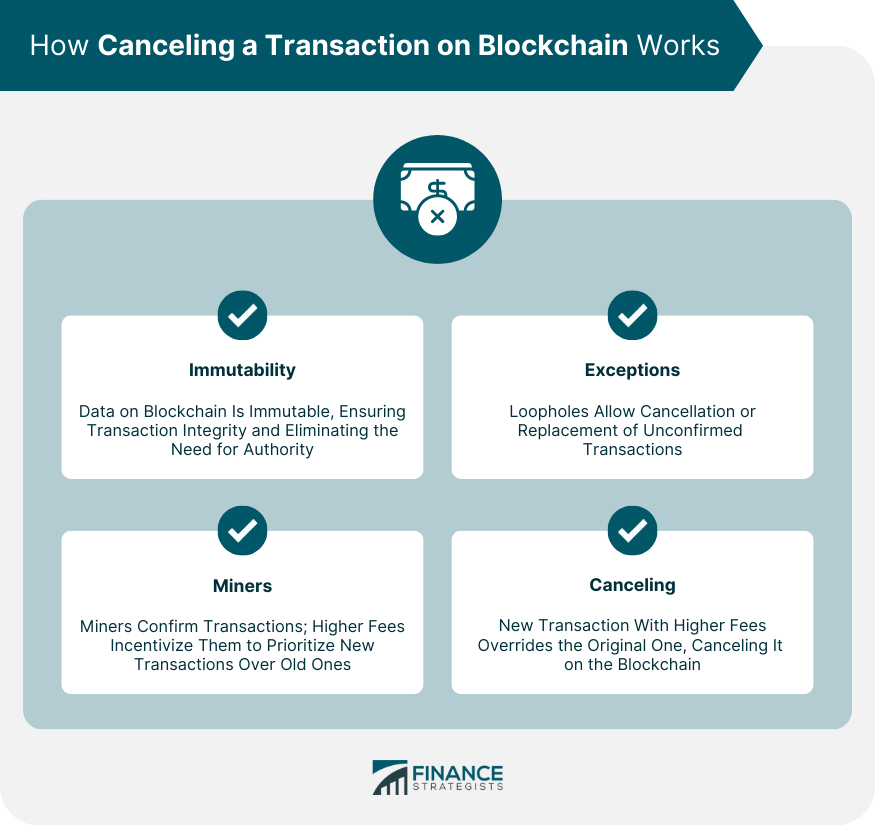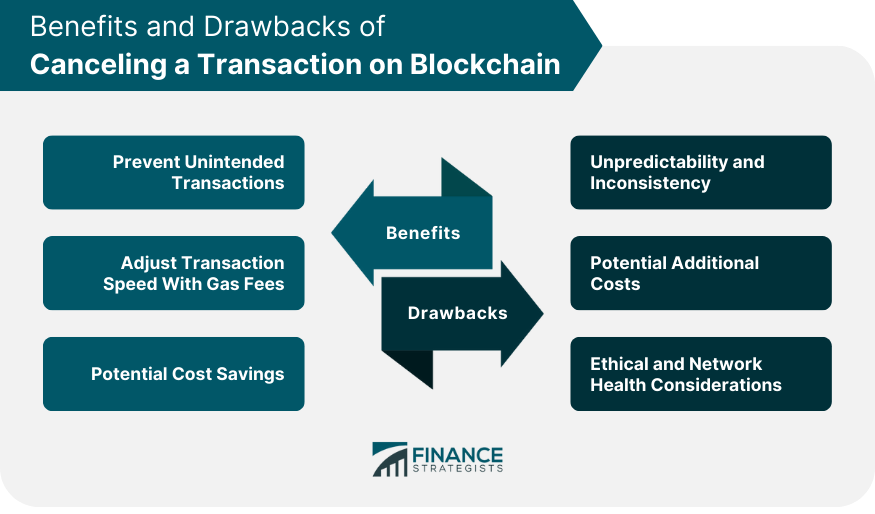When you initiate a transaction, it doesn't get added to the blockchain immediately. Instead, it goes into a transaction pool, also known as a 'mempool,' where it waits to be picked up by miners. This pool is a collection of all the transactions that have been initiated but not yet confirmed. On the Ethereum blockchain, every operation, including transactions, requires a certain amount of computational work to be performed, and this work is measured in 'gas.' Gas fees are the incentives you give miners to include your transaction in the block they are confirming. The more gas you're willing to pay, the more likely miners are to prioritize your transaction. One method of canceling a transaction on the blockchain is to initiate a new transaction with a higher gas fee that uses the same nonce (an arbitrary number used once) as the original transaction. Because miners are incentivized to confirm transactions with higher fees, they will likely pick up the new transaction first. This method is akin to a 'race' where the new transaction attempts to outpace the original one. Another method is transaction replacement, which is only possible on certain blockchain networks. On the Ethereum blockchain, for example, a new transaction can replace an old one if it has the same nonce and a gas price that is at least 10% higher. Blockchain technology is built on a principle called immutability, meaning that data, once written onto a blockchain, cannot be changed. This characteristic ensures the integrity and trustworthiness of transactions recorded on the blockchain, thereby eliminating the need for a centralized authority. When a transaction is made on a blockchain, it is bundled with other transactions into a 'block' that is added to the chain of previous transactions, hence the term 'blockchain.' While the principle of immutability is a core feature of blockchain technology, there are certain exceptions and loopholes that allow transactions to be canceled or replaced before they are confirmed. The ability to cancel a transaction relies heavily on the particular characteristics and protocols of the blockchain in question. This procedure, however, is far from straightforward and comes with its own risks and challenges. Miners play a key role in the transaction confirmation process. When a transaction is initiated, it goes into a pool of unconfirmed transactions. Miners then select transactions from this pool to confirm and add to the next block. By incentivizing miners with higher transaction fees (or gas fees in the Ethereum blockchain), one can potentially have a new transaction confirmed before the original one, effectively 'canceling' the first transaction. Being able to cancel a transaction on the blockchain can help prevent unintended transactions from being finalized. This can be particularly useful in case of human errors, such as inputting the wrong recipient address or sending the incorrect amount. The ability to cancel or replace a transaction also allows users to adjust the speed of their transactions. If a transaction is taking too long due to low gas fees, a user can effectively cancel it by sending a new transaction with a higher gas fee. In some instances, the ability to cancel a transaction can lead to cost savings. If the value of a cryptocurrency has fallen significantly while the transaction is still in the mempool, it may be more economical to cancel the transaction than to let it be confirmed. Canceling a blockchain transaction is not a guaranteed process. It is based on a race condition where you're hoping the new transaction gets picked up before the original one. Additionally, not all blockchain networks support transaction cancellation or replacement. When replacing a transaction, you will need to pay a higher gas fee, which can lead to additional costs. If the attempt to cancel the transaction is unsuccessful, you could end up paying gas fees for both transactions. Repeatedly canceling transactions can contribute to network congestion, as it results in more transactions waiting to be processed. This can lead to increased gas prices and longer confirmation times for all users. Escrow services can serve as intermediaries that hold onto the funds until all parties are satisfied. They can help prevent the need to cancel transactions by adding a layer of security and validation before the transaction is confirmed. Certain blockchain platforms are designed to allow for reversible transactions. This can provide users with more flexibility and control over their transactions but may come with its own trade-offs in terms of security and decentralization. Time locks and multisig (multi-signature) features offer additional security measures. Time locks allow transactions to be executed only after a certain time, while multisig requires multiple approvals before a transaction can be confirmed. These features can prevent the need for transaction cancellation by adding checks and balances to the transaction process. To mitigate the challenges associated with canceling transactions on the blockchain, several solutions can be employed. Utilizing escrow services adds an additional layer of security and validation, reducing the need for cancellations. Reversible blockchain platforms, specifically designed for reversible transactions, offer users more control over their transactions but may sacrifice some aspects of security and decentralization. Leveraging advanced blockchain features such as time locks and multisig capabilities can enhance security by introducing checks and balances into the transaction process. Employing these solutions helps address the drawbacks of cancellation, providing users with alternatives to navigate potential challenges and enhance their experience with blockchain transactions.Process to Cancel a Transaction on Blockchain
Transaction Pool
Gas and Gas Fees
Race Method
Replace a Transaction

How Canceling a Transaction on Blockchain Works
Overview of the Immutability Principle
Exceptions and Loopholes
Role of Miners

Benefits of Canceling a Transaction on Blockchain
Prevent Unintended Transactions
Adjust Transaction Speed With Gas Fees
Potential Cost Savings
Drawbacks and Limitations of Canceling a Transaction on Blockchain
Unpredictability and Inconsistency
Potential Additional Costs
Ethical and Network Health Considerations

Solutions to Mitigate the Drawbacks
Utilize Escrow Services
Use Reversible Blockchain Platforms
Use Advanced Blockchain Features
Conclusion
How to Cancel a Transaction on Blockchain FAQs
No, not all blockchain transactions can be cancelled. The ability to cancel a transaction depends on various factors, including the specific blockchain protocol, the status of the transaction, and the fee associated with the transaction. It's essential to understand that once a transaction is confirmed and added to a block on the blockchain, it can no longer be cancelled or altered.
Gas in the Ethereum blockchain is a measure of computational effort. Every operation, including transactions, requires a certain amount of 'gas' to be performed. Gas fees are the incentives given to miners to include your transaction in the block they are confirming. If you're willing to pay more for gas, miners are more likely to prioritize your transaction.
The ability to cancel a blockchain transaction can help prevent unintended transactions from being finalized. This can be crucial if, for instance, you've made a mistake in the recipient address or the amount to be sent. Furthermore, if a transaction is taking too long due to low gas fees, you can effectively cancel it by sending a new transaction with a higher gas fee.
Canceling a blockchain transaction is not a guaranteed process. It is based on a race condition where you're hoping the new transaction gets picked up before the original one. Also, not all blockchain networks support transaction cancellation or replacement. Additionally, the process can lead to additional costs, as higher gas fees are often required to incentivize miners to pick up the replacement transaction.
To mitigate the drawbacks of canceling a blockchain transaction, you can utilize escrow services, use reversible blockchain platforms, or leverage advanced blockchain features like time locks and multisig. Each of these methods provides additional security measures and can help prevent the need for transaction cancellation.
True Tamplin is a published author, public speaker, CEO of UpDigital, and founder of Finance Strategists.
True is a Certified Educator in Personal Finance (CEPF®), author of The Handy Financial Ratios Guide, a member of the Society for Advancing Business Editing and Writing, contributes to his financial education site, Finance Strategists, and has spoken to various financial communities such as the CFA Institute, as well as university students like his Alma mater, Biola University, where he received a bachelor of science in business and data analytics.
To learn more about True, visit his personal website or view his author profiles on Amazon, Nasdaq and Forbes.















